#aspidites melanocephalus
Text

A pair of black-headed pythons (Aspidites melanocephalus) mating in Kimberly, Western Australia
by Melissa Bruton
#black headed python#pythons#snakes#reptiles#aspidites melanocephalus#aspidites#pythonidae#serpentes#squamata#reptilia#chordata#wildlife: australia#wildlife: oceania
342 notes
·
View notes
Text

Black-headed Python (Aspidites melanocephalus), family Pythonidae, Barkly Tablelands, NT, Australia
photograph by Jesse’s Wildlife
252 notes
·
View notes
Photo

Black-headed python (Aspidites melanocephalus) at Daly Waters in the Northern Territory of Australia
Jesse Campbell
492 notes
·
View notes
Photo

Snakes are amazing misunderstood creatures. This gentle girl has never struck or bitten in all the cuddle time we've had together. Conquer your fears and get to know the scaly side of animal friends not just the fluffy ones!!
#snake#aspidites melanocephalus#black headed python#python#snek#boop the snoot#cute snoot#hippy#hippie#cute#overalls#hat#redhead#red hair#nature#green#photography#photooftheday#photoshoot#girl
2 notes
·
View notes
Note
What are your rainbow serpents like?
African Rainbow Serpents
So in Dahomey/Vodun traditions the rainbow serpent is a godlike figure called Da or Ayedo Wedo - I did not name the species of dragon after this as that is the name of a specific character in the cosmology rather than a type of dragon (…I did name the bakunawa dragon after one specific character in Philippine mythology, but that name has stuck now oops). This dragon is simply called a Rainbow Serpent or a West African Rainbow Serpent. They are in the Vivernuidae family, which is a weird place to put it but a lot of long noodle-shaped dragons are in that group.
They look like this:

Australian Rainbow Serpents
I have named Australian rainbow serpents ‘Wagyl’ after the name for rainbow serpents used by the Noongar people (south western Australia). They are part of the Mareserpinidae family, which is the sea dragon family, except the wagyl have adapted for life inland in freshwater environments. The choice to make them mareserpinids was down to most other dragons in the southern hemisphere around the Pacific being mareserpinids (such as the taniwha and mo’o) so I thought it would fit the wagyl well.
The appearance of the wagyl has not been finalised because I haven’t drawn that many of them yet, but I know they are likely to have a black or dark coloured head as there is a legend about a rainbow serpent called Kunukban (legend from Ord Victoria region - north west Australia) who had his face blackened in a fire - the patterning of this dragon may resemble that of a black headed python (Aspidites melanocephalus) which means it’ll be stripy! I’ll also probably make it iridescent because, while it’s a pain to draw, iridescent rainbow serpents are good.
Some general notes
I wanted to make the two rainbow serpents very different from eachother, which is why they are not closely related in the dragon family tree. American horned serpents are also described as multicoloured frequently, as are some small amphitheres from Europe (such as the gwiber from Wales). The horned serpents are in Longdraconidae and the amphitheres are in Vivernuidae.
14 notes
·
View notes
Photo
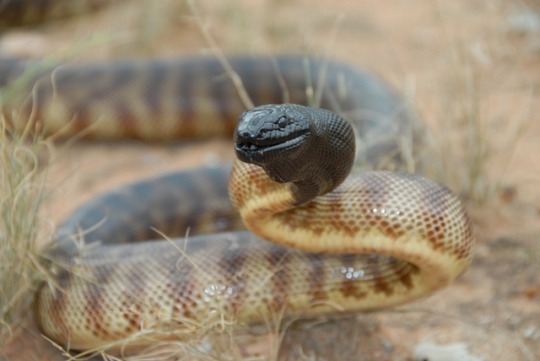
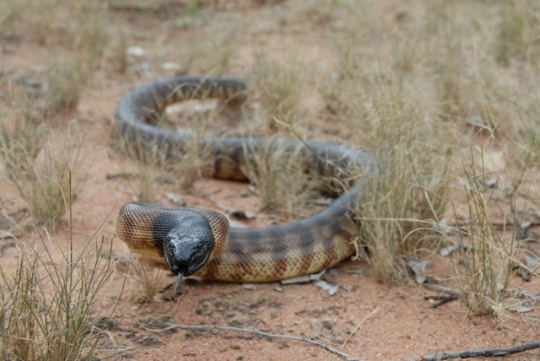
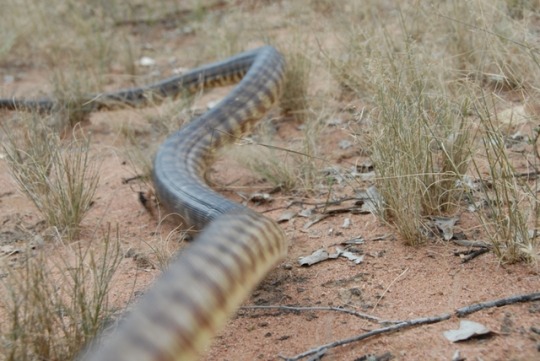
A black-headed python [Aspidites melanocephalus] racing after photographer Eric Vanderduys in Queensland, Australia.
69 notes
·
View notes
Text
Zookeeping Nonsense
So I was at the zoo with my gf the other day and we were joking about all the birds/beasts we eventually want to keep, and she made a passing comment about us needing our own zoo. Completely joking of course, but me being the incorrigible nerd that I am I started to wonder if my selection of favorites might actually be viable in a smaller zoo setting. So for those zookeepers or any other keepers of animals on my list, your opinions on it would be most appreciated. Keep in mind, this list isn’t all of my favorite animals or even all the animals I want to keep, but those I would feel relatively confident in providing adequate care for (with help) and that would do well in captivity. I do not actually intend on having a zoo, I just want to see your thoughts.
Mammals
-Red kangaroo (Macropus rufus)
-Eastern grey kangaroo (Macropus giganteus)
-Red necked wallaby(Macropus rufogriseus)
-Giant anteater (Myrmecophaga tridactyla)
-Tamandua (Tamandua spp.)
-Grey fox (Urocyon cinereoargenteus)
-Bat eared fox (Otocyon megalotis)
-Coatimundi (Nasua spp.)
-Greater kudu (Tragelaphus strepsiceros)
-Giant eland (Taurotragus derbianus)
-Warthog (Phacochoerus africanus)
-Bactrian Camel (Camelus bactrianus)
-Reeve’s muntjac (Muntiacus reevesi)
-Blue duiker (Philantomba monticola)
-African crested porcupine (Hystrix cristata)
-Lowland paca (Cuniculus paca)
-Red rumped agouti (Dasyprocta leporina)
-Llama
-Alpaca
-Barbados blackbelly sheep
-Spanish and nubian goat
-Kunekune pig
Birds
-Ruddy Duck (Oxyura jamaicensis)
-Mandarin duck (Aix galericulata)
-Pygmy Goose (Nettapus auritus)
-Black Necked Swan (Cygnus melancoryphus)
-Muscovy duck (Cairina moschata)
-Victoria Crowned Pigeon (Goura victoria)
-Pheasant Pigeon (Otidiphaps nobilis)
-Nicobar Pigeon (Caloenas nicobarica)
-Crested pigeon (Ocyphaps lophotes)
-Common Bronzewing (Phaps chalcoptera)
-Luzon Bleeding Heart (Gallicolumba luzonica)
-Kori Bustard (Ardeotis kori)
-Silver Pheasant (Lophura nycthemera)
-Lady Amherst's Pheasant (Chrysolophus amherstiae)
-Helmeted guineafowl (Numida meleagris)
-Wild Turkey (Meleagris gallopavo)
-Peacock (Pavo cristatus)
-Brush turkey (Alectura lathami)
-Rosses Turaco (Musophaga rossae)
-White cheeked turaco (Tauraco leucotis)
-Livingstone's turaco (Tauraco livingstonii)
-Red billed hornbill (Tockus erythrorhynchus)
-Laughing kookaburra (Dacelo novaeguineae)
-Superb starling (Lamprotornis superbus)
-Violet Starling (Cinnyricinclus leucogaster)
-Purple glossy starling (Lamprotornis purpureus)
-White crested laughing thrush (Garrulax leucolophus)
-Red-legged Honeycreeper (Cyanerpes cyaneus)
-Bearded Barbet (Lybius dubius)
-Red-crested Cardinal (Paroaria coronata)
-Pekin Robin (Leiothrix lutea)
-Emu (Dromaius novaehollandiae)
-Ostrich (Struthio camelus)
-Greater Rhea (Rhea americana)
Reptiles
-Blue tongue skink (Tiliqua scincoides)
-Shingleback Skink (Tiliqua rugosa)
-Monkey tailed skink (Corucia zebrata)
-Fire skink (Lepidothyris fernandi)
-Crested gecko (Correlophus ciliatus)
-Mossy prehensile tailed gecko
-Leachie Gecko (Rhacodactylus leachianus)
-Mourning gecko (Rhacodactylus chahoua)
-Fat tailed gecko (Hemitheconyx caudicinctus)
-Knob tailed gecko (Nephrurus spp.)
-Giant day gecko (Phelsuma grandis)
-Black and white tegu (Salvator merianae)
-Caiman lizard (Dracaena guianensis)
-Black spiny tailed iguana (Ctenosaura similis)
-Rhinoceros iguana (Cyclura cornuta)
-Gila monster (Heloderma suspectum)
-Mexican beaded lizard (Heloderma horridum)
-Long tailed boa constrictor (Boa constrictor longicauda)
-Rubber boa (Charina bottae)
-Carpet python (Morelia spilota)
-Boelen's python (Morelia boeleni)
-Black headed python (Aspidites melanocephalus)
-Cuviers Dwarf caiman (Paleosuchus palpebrosus)
-African spurred tortoise (Centrochelys sulcata)
-Matamata (Chelus fimbriata)
Amphibians
-Solomon island leaf frog (Ceratobatrachus guentheri)
-African bullfrog (Pyxicephalus adspersus)
-Horned frogs (Ceratophrys spp.)
-Budgett's frog (Lepidobatrachus laevis)
-Bumblebee dart frog (Dendrobates leucomelas)
-Dyeing dart frog (Dendrobates tinctorius)
-Green and black poison dart frog (Dendrobates auratus)
-Mimic Poison dart Frog (Dendrobates imitator)
-Vietnamese mossy frog (Theloderma corticale)
-Amazon milk frog (Trachycephalus resinifictrix)
-Waxy monkey tree frog (Phyllomedusa sauvagii)
@the-awkward-turt @thezookeepersdiary @thezookeeperslife @zookeeperproblems @zookeeperrick @zookeepingitreal @thechilidog @uroplatus @ccortez07
4 notes
·
View notes
Photo

Black-Headed Python
Aspidites melanocephalus
Photographed in situ during my herping trip to Australia. This was barely a yearling hatchling found, with adult lengths reaching up to 10ft. Their diets primarily consist of other reptiles, namely skinks and other lizards. See the video of our epic finds HERE.
19 notes
·
View notes
Photo
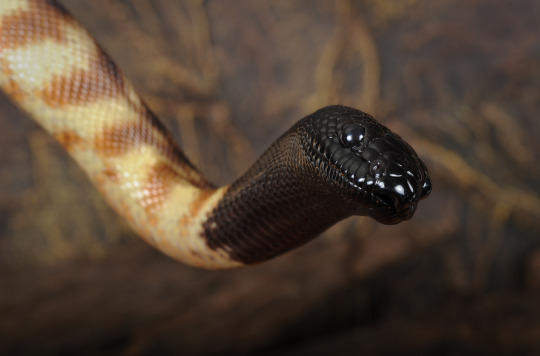
Todays Snake Is:
The Black-headed Python (Aspidites melanocephalus) is a constrictor native to northern Australia. Their unique head and neck coloration is used for thermoregulation, allowing them to warm up more easily without leaving their entire bodies exposed to predators. In the wild, they feed mostly on other reptiles, including venomous snakes.
(x)
326 notes
·
View notes
Text
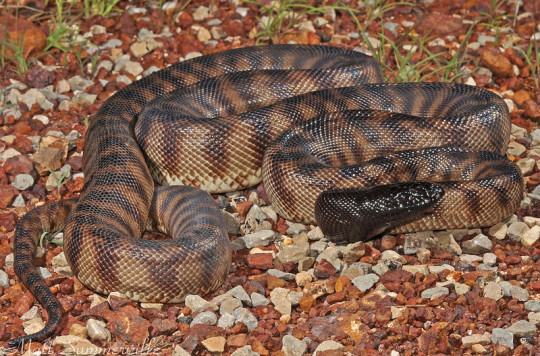
A black-headed python (Aspidites melanocephalus) at Daly Waters, Northern Territory, Australia
by Matt Summerville
#black headed python#pythons#snakes#reptiles#aspidites melanocephalus#aspidites#pythonidae#serpentes#squamata#reptilia#chordata#wildlife: australia#wildlife: oceania
58 notes
·
View notes
Photo
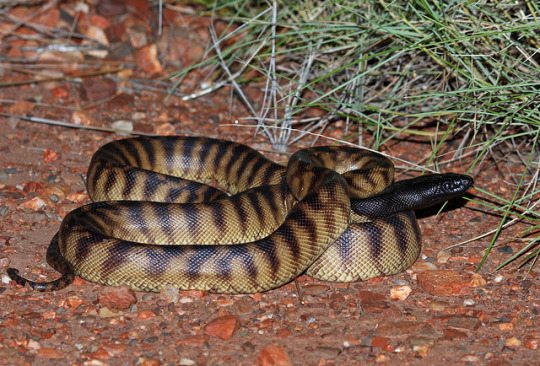
Black-headed Python
The Black-headed Python, Aspidites melanocephalus (Pythonidae), is an Australian species of python with an average length of 155cm.
These distinctive pythons have a glossy jet black head that ends abruptly just behind the neck. The eyes are also black and the pupils are almost invisible. The body is light brown to dark caramel with dark cross bands along the entire body. The bands are darkest dorsally and fade towards the ventral scales. The belly is light cream speckled with darker spots.
Unlike other pythons, this one lacks heat sensing pits, probably due to a large percentage of their prey being cold blooded.
The scientific name comes from Aspidites, meaning 'shield-bearer', in reference to the large scales on the head; and melanocephalus, meaning 'black head'.
References: [1] - [2]
Photo credit: ©Ryan Francis
Locality: Lena Creek, Mount Isa, Queensland, Australia
#nature#animals#black-headed python#aspidites melanocephalus#aspidites#australia#fauna#wildlife#python#reptiles#reptilia#squamata#serpentes#pythonidae#zoology#herpetology#original
200 notes
·
View notes
Photo
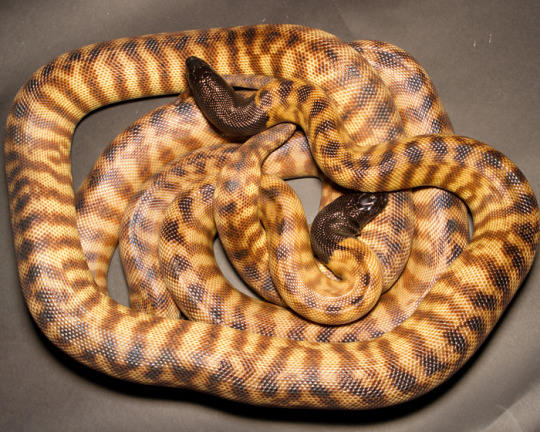
Black-Headed Python (Aspidites melanocephalus) from Designer Serpents
49 notes
·
View notes
Text
Black-Headed Python
Aspidites melanocephalus
Aspidites translates to shield owner (belonging to), while melanocephalus means black-head.
Family: Pythonidae (Pythons)
Fun Fact: "During cooler temperatures, evidence suggests that when termite nests are present, they tend to burrow into these habitats as a way of maintaining a stable body temperature. When termite mounds were not present, they adopted specific postures and modified their behavior to prevent extreme cooling. The glossy, black head that is characteristic of this species helps regulate body temperature as well, allowing the majority of the snake’s body to remain hidden while it extends only its head from its burrow." (ADW).
Habitat: They are endemic to scrublands, savannas, and forests of the northern 1/3 of Australia (including most of the Northern Territory, northern Queensland, and northern Western Australia).
Ecosystem Role: They help control populations of bearded dragons, skinks, geckos, perenties, smaller snakes, legless lizards, and occasionally mammals and birds. They are preyed upon mostly by humans and dingos.
1 note
·
View note
Photo

SO MUCH WANT!!!!!
49 notes
·
View notes